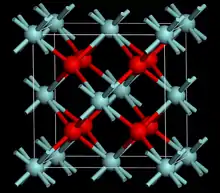Cerium anomaly
The cerium anomaly, in geochemistry, is the phenomenon whereby cerium (Ce) concentration is either depleted or enriched in a rock relative to the other rare-earth elements (REEs).[1] A Ce anomaly is said to be "negative" if Ce is depleted relative to the other REEs and is said to be "positive" if Ce is enriched relative to the other REEs.[1]
Cerium oxidation states
Cerium is a rare-earth element (lanthanide) characterized by two different redox states: III and IV. Contrary to other lanthanide elements, which are only trivalent (with the notable exception of Eu2+), Ce3+ can be oxidized by atmospheric oxygen (O2) to Ce4+ under alkaline conditions.[2]
The cerium anomaly relates to the decrease in solubility, which accompanies the oxidation of Ce(III) to Ce(IV). Under reducing conditions, Ce3+ is relatively soluble, while under oxidizing conditions CeO2 precipitates.[1] Sediments deposited under oxic or anoxic conditions can preserve on the long term the geochemical signature of Ce3+ or Ce4+ upon reserve that no early diagenetic transformation altered it.[1]
Cerium anomalies in zircon

Zircon (ZrSiO4) is commonly found in felsic igneous rock.[3] Because both Ce3+ and Ce4+ can substitute for zirconium, Zircon often has a positive Ce anomaly.[3] Ce4+ substitutes with Zr much more easily than Ce3+ because Ce4+ (ionic radius 0.97Å) has the same charge and a similar ionic radius as Zr4+ (ionic radius 0.84Å).[1] Therefore, the oxidation state of the magma is what determines the Ce anomaly in Zircon.[3] If the oxygen fugacity is high, more Ce3+ will oxidize to Ce4+ and create a larger positive Ce anomaly in the zircon structure. At lower levels of oxygen fugacity, the level of Ce anomaly will also be lower.[3]
Cerium anomalies in coal
Negative cerium anomalies
Cerium in coal is typically weakly negative, meaning that it is present at slightly lower concentrations than the other rare-earth elements.[2] Cerium anomalies in coal are influenced by the sediment source region.[2] Coal mined from mafic regions dominated by basalts, such as the location of the Xinde Mine in China, does not have a Ce-anomaly.[2] In contrast, coal mined in felsic rock regions, such as Guxu Coalfield in China, does have weakly negative Ce-anomalies.[2] Negative Ce-anomalies can also be attributed to the weathering and oxidation of the coal-mining region.[2] During oxidation, Ce3+ precipitates out as CeO2, leaving less Ce in the coal.[1]
Positive cerium anomalies
While cerium anomalies in coal are usually negative, they can rarely be positive as well.[4] This can occur during volcanic eruptions when volcanic ash is weathered into mafic tuffs with positive Ce-anomalies.[1] The Pavlovka deposit in Far East Russia has large positive Ce-anomalies in its Fe-Mn oxyhydroxide ores.[4] Because cerium is one of only two REEs that can obtain an oxidation number of +4, Ce4+ is absorbed into Mn(IV) oxides instead of other REEs and this results in a positive Ce-anomaly.[4]
References
- Thomas, J. B.; Bodnar, R. J.; Shimizu, N.; Chesner, C. A. (2003). "Melt Inclusions in Zircon". Reviews in Mineralogy and Geochemistry. 53 (1): 63–87. Bibcode:2003RvMG...53...63T. doi:10.2113/0530063. ISSN 1529-6466.
- Dai, Shifeng; Graham, Ian T.; Ward, Colin R. (2016). "A review of anomalous rare earth elements and yttrium in coal". International Journal of Coal Geology. 159: 82–95. doi:10.1016/j.coal.2016.04.005. ISSN 0166-5162.
- Zhong, Shihua; Seltmann, Reimar; Qu, Hongying; Song, Yingxin (2019). "Characterization of the zircon Ce anomaly for estimation of oxidation state of magmas: a revised Ce/Ce* method". Mineralogy and Petrology. 113 (6): 755–763. doi:10.1007/s00710-019-00682-y. ISSN 0930-0708. S2CID 201713664.
- Laveuf, C.; Cornu, S. (2009). "A review on the potentiality of Rare Earth Elements to trace pedogenetic processes". Geoderma. 154 (1–2): 1–12. doi:10.1016/j.geoderma.2009.10.002.